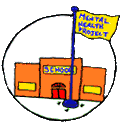July
| To download a copy of this material in pdf format, click here. |
Over a school year, it is hard to find enough time to stop, think, and plan new ways of doing things.
It is a bit like Winnie the Pooh's experience going downstairs. As Milne describes it:
| "Here is Edward Bear, coming downstairs now, bump, bump, bump, on the back of his head, behind Christopher Robin. It is, as far as he know, the only way of coming downstairs, but sometimes he feels that there really is another way, if only he could stop bumping for a moment and think of it." |
The month of July in many schools is "down time." (For year-long schools, intersessions are comparable times.) Down time provides an opportunity to stop and think long enough to plan better ways of doing things. Such time blocks can allow staff who work year round to plan new ways of providing and enhancing supports for student learning. Such periods also allow for special training opportunities.
Time to Think About Building a Learning Supports Component
As is described in this series of monthly ideas for enhancing support at a school, there is a rhythm to the course of a school year. Varying demands arise every month. Knowing these cyclical demands helps to anticipate and plan what to do to support students and enable learning. At most schools, support staff have had to keep "bumping their heads" as they struggle each day to meet the demands on them. This usually means reacting with a limited set of piecemeal and fragmented strategies. Now is the time to think about how to become proactive and more effective.
The aim should be to set a process into motion that can lead to development of a comprehensive and cohesive component to address barriers to student learning and promote healthy development. Such a component has been called an enabling or learning supports component. Planning and developing such a component not only can end fragmented approaches, it can move toward eliminating the counterproductive competition for resources and end the marginalization of student support staff. (See the Guidelines for a Student Support Component.)
Building an enabling or learning supports component requires enhancing the capacity of a school's support staff so that they can be more effective in addressing the many factors that interfere with students succeeding at school. One way to enhance the capacity of support staff is to develop a mechanism that enables them to work together on a regular basis.
Time to Think About Establishing a Resource-Oriented Mechanism
A Resource Coordinating Team provides a good example of a resource-oriented mechanism designed to develop an enabling or learning supports component at a school.
|
Every school that wants to improve its systems for providing student support needs a mechanism that focuses specifically on improving resource use and enhancement. A Resource Coordinating Team is a vital form of such a mechanism. Most schools have teams that focus on individual student/family problems (i.e., case-oriented teams). These teams focus on such functions as referral, triage, and care monitoring or management. In contrast to this case-by-case focus, a school's Resource Coordinating Team can take responsibility for enhancing use of all resources available to the school for addressing barriers to student learning and promoting healthy development. This includes analyzing how existing resources are deployed and clarifying how they can be used to build a comprehensive, multifaceted, and cohesive approach. It also integrally involves the community with a view to integrating human and financial resources from public and private sectors to ensure that all students have an equal opportunity to succeed at school. What are the functions of a resource coordinating team? A Resource Coordinating Team performs essential functions related to the implementation and ongoing development of a comprehensive, multifaceted, and cohesive approach for addressing barriers to student learning and promoting healthy development.
Examples of key functions are:
Who's on a Resource Coordinating Team?
A Resource Coordinating Team might begin with only two people. Where feasible, it should expand into an inclusive group of informed stakeholders who are able and willing. This would include the following:
|
It is important to integrate the Resource Coordinating Team with the infrastructure mechanisms at the school focused on instruction and management/governance. For example, the school administrator on the team must represent the team at administrative meetings; there also should be a representative at governance meetings; and another should represent the team at a Resource Coordinating Council formed for the feeder pattern of schools.
Tools and Aids for Developing and Guiding the Work of a Resource Coordinating Team
- Resource-Oriented Teams: Key Infrastructure Mechanisms for Enhancing Education Supports
- Addressing Barriers to Learning: A Set of Surveys to Map What a School Has and What it Needs
- Resource Mapping and Management to Address Barriers to Learning: An Intervention for Systemic Change
- Guidelines for a Student Support Component
|
Working together enables a small group of dedicated stakeholders not only to anticipate the predictable demands of the school year, it enables them to proactively use scarce resources in ways that help many more students and staff meet the mission of the school.
"Never doubt that a small group of thoughtful, committed people can change the world.
Indeed, it is the only thing that ever has." Margaret Mead
|
| To download a copy of this material in pdf format, click here. |
|
Center for Mental Health in Schools WebMaster: Perry Nelson (smhp@ucla.edu) |
 |